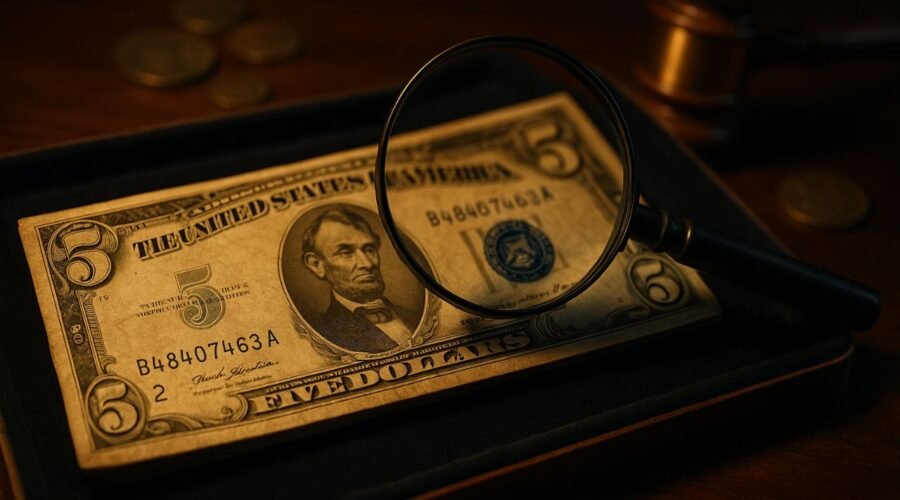Rare 1928 $5 Bills- Distinctive Notes With Unique Characteristics
The 1928 $5 bill is a significant piece of U.S. currency history, marking the transition from large-size to small-size notes.
Issued as both Legal Tender Notes (red seal) and Federal Reserve Notes (green seal), these bills are highly sought after by collectors due to their unique features and variations.
Design Features
Obverse Side
- Portrait: Features a portrait of Abraham Lincoln, the 16th President of the United States.
- Seal and Serial Numbers: Legal Tender Notes display a red Treasury seal and matching red serial numbers, while Federal Reserve Notes have a green seal and serial numbers.
Reverse Side
- Design: Depicts the Lincoln Memorial in Washington, D.C., with the denomination “FIVE DOLLARS” prominently displayed.
- Background: The reverse side is characterized by a green background, a standard feature for U.S. currency at the time.
Series Variations
The 1928 $5 bill was issued in several series, each with distinct characteristics:
- 1928 Series: The original release featuring the red seal and serial numbers.
- 1928A Series: Introduced minor design changes while maintaining the red seal.
- 1928B Series: Marked by further design refinements and continued use of the red seal.
- 1928C Series: Featured additional modifications to the design elements.
- 1928D Series: Noted for its rarity and unique design features.
- 1928E Series: Continued the trend of design evolution.
- 1928F Series: The final series in the 1928 series, showcasing the culmination of design changes.
Collectibility and Value
The value of a 1928 $5 bill varies based on several factors:
- Condition: Bills in uncirculated condition are significantly more valuable than those that are circulated.
- Series: Some series, like the 1928D, are rarer and thus more sought after by collectors.
- Star Notes: These are replacement notes issued when a bill was damaged during printing. Star notes are typically more valuable due to their rarity.
- Serial Numbers: Fancy serial numbers, such as those with repeating digits or patterns, can increase a bill’s value.
Rarity and Special Features
Certain features can make a 1928 $5 bill exceptionally rare:
- Mule Notes: These are bills with mismatched front and back plates, leading to design anomalies.
- Late-Finished Back Plate (LFBP) #637: A specific back plate used in the printing process, making bills featuring it more valuable.
- Late-Use Back Plate #629: Another back plate variation contributing to the bill’s rarity.
- Micro or Macro Backplates: Variations in the size of the back plate used during printing can affect the bill’s value.
Key Features of 1928 $5 Bill
| Feature | Description |
|---|---|
| Portrait | Abraham Lincoln |
| Seal Color | Red Treasury Seal (Legal Tender Notes), Green Seal (Federal Reserve Notes) |
| Serial Numbers | Matching the seal color |
| Reverse Design | Lincoln Memorial with green background |
| Series Variations | 1928, 1928A, 1928B, 1928C, 1928D, 1928E, 1928F |
| Collectibility Factors | Condition, Series, Star Notes, Fancy Serial Numbers, Printing Anomalies |
The 1928 $5 bill is more than just a piece of currency; it’s a historical artifact that offers a glimpse into the past. Its unique features and variations make it a prized possession for collectors.
Whether you’re a seasoned numismatist or a casual enthusiast, understanding the intricacies of this bill enhances its appreciation and value.
FAQs
What makes the 1928D $5 bill rare?
The 1928D $5 bill is rare due to its limited issuance and unique design features, making it highly sought after by collectors.
How can I determine the value of my 1928 $5 bill?
The value depends on factors like condition, series, presence of star notes, and unique serial numbers. Consulting a currency grading expert or reference guide can provide an accurate assessment.
Are 1928 $5 bills still legal tender?
Yes, 1928 $5 bills are still considered legal tender. However, their value as collectibles often exceeds their face value.


Leave a Reply